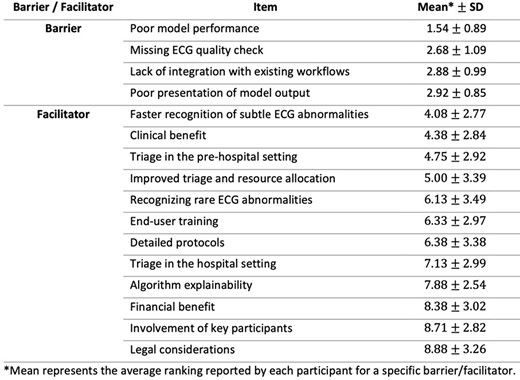-
PDF
- Split View
-
Views
-
Cite
Cite
B Arends, J Mccormick, P Heus, P Van Der Harst, R Van Es, Barriers and facilitators for implementation of AI algorithms for ECG analysis and triage in patients with chest pain, European Heart Journal, Volume 45, Issue Supplement_1, October 2024, ehae666.3487, https://doi.org/10.1093/eurheartj/ehae666.3487
Close - Share Icon Share
Abstract
Numerous artificial intelligence (AI) algorithms have been developed to assist in clinical decision-making, with a focus on areas like electrocardiogram (ECG) analysis due to the signal complexity and the varying levels of expertise among healthcare professionals. However, ensuring acceptance of these algorithms by end-users is paramount for successful implementation.
This study aimed to identify barriers and facilitators related to implementation of an AI algorithm for ECG analysis and triage in patients with chest pain.
A three-round modified electronic Delphi study was conducted among Dutch potential end-users of an ECG-AI algorithm, including physicians, nurses and ambulance professionals. During the first round, participants brainstormed on barriers and facilitators, which were subsequently mapped to the Consolidated Framework for Implementation Research (CFIR). In the following two rounds, participants reviewed the identified barriers and facilitators for relevance and ranked them according to their importance.
Twenty-five out of the initial forty respondents completed all three rounds, resulting in a dropout rate of 38%. Four barriers and twelve facilitators were identified. The most important facilitator was "Faster recognition of subtle ECG abnormalities", while "Poor model performance" emerged as the most important barrier. The most frequently mentioned corresponding CFIR domains were the innovation and inner setting domains.

Barriers and facilitators
Author notes
Funding Acknowledgements: Type of funding sources: Public grant(s) – National budget only. Main funding source(s): Health~Holland, UMC Utrecht - AIOMI-ECG



